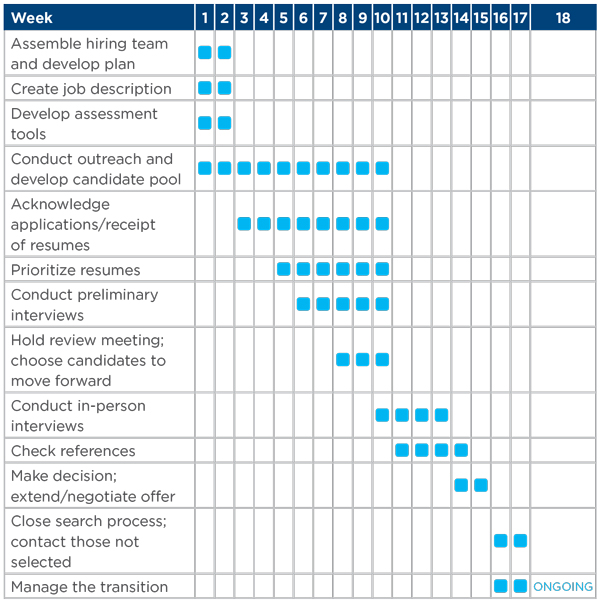The first step in this process is to identify a team of individuals in your organization to be part of the hiring process. Why form a hiring team? These team members will help you scope the position, screen resumes, interview, and manage your new hire’s transition.
From writing a job description to conducting interviews to extending an offer, a disciplined, rigorous search process will mitigate the risks of hiring new employees for your nonprofit organization. This tutorial provides step-by-step advice from recruiting experts to help you hire with confidence.
Are You Hiring?
Post your jobs on Bridgespan's Nonprofit Job Board and find great candidates for your organization.Learn more
Who should be on your team and how and when should they be involved in the search process? This depends on your organization. Your team may consist of 2-10 members, depending on the size of your organization and the level of the position. You also may wish to include board members or other volunteers on the team, particularly if you do not have a large staff. In general, a CEO/executive director (ED) search will involve board, staff, and possibly search professionals; direct reports to the ED will tend to involve 1-3 staff members and possibly search professionals, but typically not the board. Once you have selected the team, clearly outline each team member’s responsibilities.
The role of the team is to fully engage in the search process. Members can offer a range of perspectives on the position, the candidate profile, and how specific candidates do and do not fit the profile; communicate about the search to the organization; and provide an open forum for discussion and dissent about which candidate to choose. Once you have selected the team, it is helpful to clearly outline each team member’s responsibilities (e.g., Who will be in charge of managing incoming resumes? How much interviewing will each team member do?) The team also needs to determine a process for finalist selection: Will one individual (e.g., the ED) be responsible for the final choice? Will a subset of the hiring team make the decision?
You can break down the team’s tasks into a simple list that makes it easier to manage team members’ roles and responsibilities:
- Identify organizational needs
- Define the position and identify characteristics of the ideal candidate (include hard skills, soft skills, and preferred work style)
- Write the job description
- Network and advertise the opening
- Gather, organize, and screen resumes
- Assess candidate resumes according to established criteria to reduce pool of candidates suitable for preliminary interviews
- Conduct preliminary interviews (by phone or video technology such as Skype, videoconferencing, and/or FaceTime)
- Assess candidates again on the basis of in-person interviews, and advance leading candidates to next steps in the interview process
- Choose finalists and conduct reference checks
- Make the final choice, and extend and negotiate the offer
- Notify participants who were not chosen
- Thank all who helped in the search
- Help think through the transition
When the team is in place, and before you begin to write a job description, think holistically about what your organization needs in order to deliver on its mission and goals. Some questions to ask include:
- What are our strategic goals and what will it take to get there?
- What are the roles and responsibilities of our current staff members? What are their strengths and development opportunities? How are they aligned to help us achieve our goals?
- Having outlined the strategic goals and how existing staff members contribute to meeting those goals, what role and responsibility gaps begin to emerge?
- What are the expectations for this newly created position? What are the roles and responsibilities? How does this role fit within the existing team structure? What experience and/or specific functional qualifications will the new position require?
- What is the general compensation range for this position in the marketplace and for the level of the position in your organization? What other compensation components (e.g., health/dental/vision, vacation, retirement program, relocation reimbursement, etc.) are we able to offer?
The answers to these questions should start to provide you and your team with a sketch of what the position will look like. This is a good point in the process to conduct a reality check. Based on the analysis completed thus far, is the organization structured in a way that will allow you to achieve your strategic goals? Will making this hire help you fill your gaps? Can the requirements that the team has sketched out realistically be found in one person or does the organization require restructuring? If you have determined that your organization is well-structured but requires the new hire to complete the team, you can begin to write the job description. If not, it’s important to gain clarity on the ideal structure and how to get there before moving forward.
Sample Recruiting Timeline


